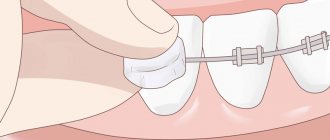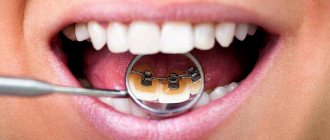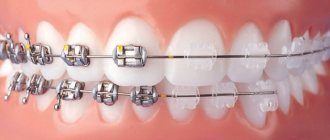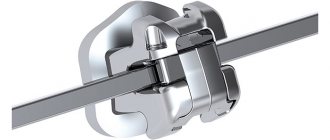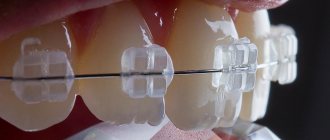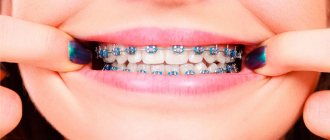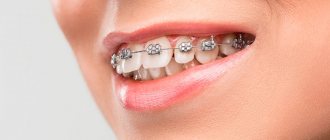What are self-ligating braces?
The operating principle of a non-ligature construction is easiest to understand if you compare it with a ligature construction.
Classic ligature braces: clasps are fixed on the surface of each tooth and connected to each other by an orthodontic arch. The clasps and arch are attached to each other with fasteners - ligatures. They can be special rubber bands or wires. These elements gradually move the teeth and bite into the position specified by the orthodontist. This happens due to the teeth overcoming the frictional force. The disadvantage of ligatures is that during the treatment they need to be changed frequently, as they stretch, cease to perform their function, plus they lose their original aesthetic appearance - they change color.
To make orthodontic treatment more comfortable for the patient, manufacturers of dental corrective structures have developed braces without ligatures. They differ from classic ligature ones in the way the clasps and arches are connected: the latches in them are replaced with special latched covers built directly into the clasps themselves. It turns out that the locks seem to be strung on an arc, and not attached to it with “clothespins”.
During treatment with ligature-free braces, the frequency of visits to the dentist is reduced: the fixing elements in them do not fail, so the structure needs to be adjusted much less frequently.
Wearing ligature and non-ligature braces: what is the difference?
Both types of structures effectively perform their task - correct the pathology of teeth closure, return teeth to the anatomically correct position. But for the patient, the process of wearing them will be different.
- Non-ligature designs look neater, “lighter”, more inconspicuous: they have no additional elements, and the clasps themselves are smaller.
- Caring for self-ligating systems is much easier: metal and rubber ligatures often contain food fragments and need to be cleaned more thoroughly and for longer.
- The main difference we have already mentioned is the frequency of correction. When wearing classic ligature braces, you need to visit the orthodontist every three to four weeks, and when wearing non-ligature braces - every six to eight weeks. For many patients, this is a decisive moment when choosing an orthodontic system.
Photos of treatment stages on self-ligating braces
Adaptation and care of self-regulating brace systems
Despite the fact that non-ligature structures take up less space in the oral cavity, the patient will still feel a foreign object in the mouth. There may be problems with diction that did not exist.
The adaptation period takes from a couple of weeks to several months, and each patient experiences it individually.
After installing any braces, you need to ensure maximum oral hygiene. To brush your teeth, you may need a special toothbrush; the duration of brushing increases over time. If you do not pay due attention to this, caries will form under the locks. And while wearing the device, your teeth will be seriously damaged.
Also, after removing the braces, professional teeth cleaning is a mandatory procedure.
What materials are ligature-free braces made from?
Locks for self-ligating structures are made from the same materials as for classic ligature braces - metal, ceramics and artificial sapphires.
Metal self-ligating braces
They are the easiest to install and remove. These durable, reliable systems correct all malocclusion pathologies and effectively move teeth into the desired position. Cheaper than designs made from other materials, therefore popular with patients.
Self-ligating ceramic braces
They are made from durable white dental ceramics in different shades, so they look more attractive than metal ones. The clasps of such systems are invisible, since the ceramics merge with the tooth enamel. The only noticeable detail is the orthodontic arch. They have one drawback - fragility compared to structures made from other materials.
Sapphire self-ligating braces
Like ceramic ones, they are almost invisible on the teeth. They are, of course, not made from natural sapphires - otherwise their price would be very high. During production, a transparent artificial material is used, the characteristics of which are identical to sapphires. They reflect light and make your smile really sparkle. Sapphire braces are more often used in the treatment of complex malocclusion pathologies; they are stronger than ceramic ones.
Features of non-ligature orthodontic systems
- This is a special design consisting of clasps attached to each other with a metal arc and fixed to the teeth.
- Self-adjusting braces are secured using movable devices. This allows for quick and easy correction of the system, as well as changing the arc if necessary.
- Modern fasteners, which are convenient latches, latches or clips, block the arc, allowing you to avoid fixed fixation. Thanks to this unique system, teeth take the desired position without effort and increased friction. This opportunity was highly appreciated by orthodontic patients.
Aesthetic system without ligatures - what is it?
It is widely believed that non-ligature braces are a type of aesthetic system. In fact, this is only partly true.
Aesthetic self-ligating braces include ceramic and sapphire designs. Metal ones, although they look more attractive than ligature systems due to small locks, can hardly be called aesthetic. They look neat, but are much more noticeable than designs made of ceramics and artificial sapphires.
Also, aesthetic non-ligature braces include lingual systems - they are attached to the “lingual”, inner surface of the teeth. Such designs are invisible and are often chosen by public people.
The only drawback of non-ligature aesthetic systems is their high price. In order to reduce it, dentists combine materials: in the frontal zone, sapphire or ceramic clasps are fixed on the upper teeth, and metal ones on the lower jaw, chewing teeth.
Main brands of self-ligating non-ligating braces
Popular brands of non-ligation systems include Damon, Clarity, Experience, In Ovation, H4.
Damon.
Perhaps the most famous brand of braces without ligatures. Its product line includes designs to solve any problems with bite and misalignment of teeth. The main advantage of these American systems is the damper mount developed by the company. It simplifies the archwire replacement process and reduces correction time.
Experience.
Japanese non-ligature designs, characterized by the small size of the clasps and their structure. Each clasp fits very tightly to the tooth enamel. Plus Experience controls the movement of each tooth.
Clarity SL.
Damon's main competitors. They are made of ceramic, but the groove in their clasps is made of stainless steel. This guarantees smooth sliding of the arc, as in metal systems. At the same time, they are classified as aesthetic systems, since they are invisible on the teeth. Treatment duration with Clarity SL is typically reduced by 25%. However, it all depends on the clinical picture.
In Ovation C.
These are ceramic non-ligature structures from the American company DENTSPLY. These systems are designed to prevent incorrect fixation. In Ovation C clasps are 100% protected from discoloration during wear - for this, the manufacturer coated them with a layer of zirconium dioxide.
H4.
Another self-ligating braces made in America. They are distinguished by a low profile of the locks and a minimum size of the groove for the orthodontic arch. Allows better control of treatment at the final stage.
The best models of non-ligature metal braces
- Damon Q. Implantmaster orthodontists correct the bite using self-ligating metal braces Damon Q. These braces perfectly correct difficult clinical cases in the shortest possible time. The system itself is perfectly individualized for each patient.
- Damon 3MX. For a long period of time, these plates were considered the most effective among non-ligature ones. The main advantages are smooth edges and a small width of the plate, which ensures comfortable wearing and quick adaptation;
- Smart Clip. The system has an exclusive patented plate snap mechanism. This ensures precise control of the arc force, and the ability to change it to increase the efficiency of bite correction;
- In-ovation R. A small bracket system that allows you to fix arches of different sizes in the grooves. Also, the unique structure of the structure has an additional effect on the arch, reducing the period of corrective treatment.
How are ligature-free systems installed?
The process of fixing self-ligating non-ligature structures is no different from installing classical ligature systems.
- Before fixing the structure, a full examination of the oral cavity is carried out; sometimes, to achieve the desired result of orthodontic treatment, teeth are removed and dentures are installed. All carious lesions must be removed and professional cleaning carried out.
- Locks of the chosen design are fixed to the teeth. This happens with the help of dental glue. This is the most critical stage: incorrectly installed locks will negatively affect the duration and quality of treatment.
- If necessary, the remaining glue is removed, and the clasps are finally secured to the teeth using a lamp with ultraviolet light.
- On the side, on the chewing teeth, orthodontic rings and locks are fixed.
- All installed locks are connected to each other by means of an orthodontic arch, which is fixed in their grooves.
Installation of the system takes about one hour. But the preparatory stage may well last for several weeks or even months - it all depends on the initial condition of the patient’s oral cavity.
Positive qualities of using ligature-free braces
- They take up little space in the mouth, which allows the patient to quickly adapt to them and facilitate dental care.
- The only solution for patients with periodontal disease.
- The patient does not waste his time, but comes for an appointment once every 2-3 months.
- The arc change time thanks to the clamps is 10-15 minutes.
- A positive result is achieved faster and lasts for a long time.
- The incidence of trauma when using ligature-free brace systems drops to almost zero due to the slight pressure on the oral mucosa.
- There is no interaction with the environment in the oral cavity, since production is carried out only from proven and clean materials.
- When the bite is corrected, there will be no need to remove teeth.
- Continuous operation of arcs, without the help of a specialist.
- The design also looks quite nice.
- Removal and installation of braces occurs quickly.
Which braces to choose - with or without ligatures?
Non-ligature braces look more aesthetically pleasing than classic ligature braces, reduce the number of visits to the orthodontist, correct the bite faster, move teeth more gently, and can be used for periodontal diseases. Thanks to the design of self-ligating systems, the process of their correction takes fifteen to twenty minutes. In addition, the absence of ligatures protects against pain that can occur if the orthodontist “tightens” the ligature.
The disadvantage of self-ligating structures is their high price. Apparently, for this reason, classic ligature systems are still very popular. They are especially often chosen by teenagers and young people, who, in addition to saving money, receive another bonus - the opportunity to experiment with the color of the ligatures, making their braces unique, emphasizing their individuality.
In general, when choosing an orthodontic system, doctors and patients are guided by two principles - the ability to effectively get rid of malocclusion pathology and the ability to pay for treatment. Both ligature and non-ligature constructions allow you to achieve the desired result.
